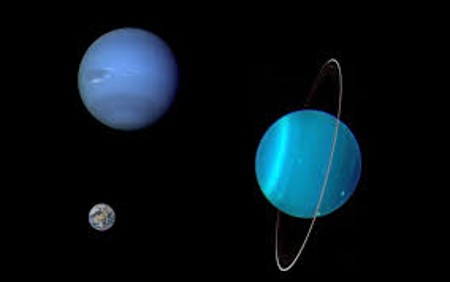March 5, 2020 – A robotic spacecraft from Earth, Voyager 2, has given us the best opportunity to see and study two of the Solar System’s remote ice giants, Uranus and Neptune. Two spacecraft named Voyager were launched in the 1970s because of a moment when the outer planets were perfectly aligned for a multi-planet flyby. Voyager 1 visited Jupiter and Saturn. Voyager 2 visited those two and then went on to Uranus and Neptune. The planetary alignments for such a voyage come up rarely so if planetary scientists see an opportunity they want to go for it.
Just such an event is going to happen early in the 2030s when Jupiter, Uranus, and Neptune will be positioned just right for a visit. The key to achieving the voyage in a reasonable timeframe is the gravity of Jupiter. Sending two probes complete with a battery of state-of-the-art instrumentation would increase our knowledge of these two outer planet ice giants dramatically.
The infrastructure for the instrumentation on Voyager 1 and 2 is late 1960s early 1970s and includes:
- a computer command system designed for navigation and communication with 69.63 kilobytes of memory, enough to store an average Internet .jpeg file produced today.
- a system capable of executing 81,000 instructions per second (the average smartphone is 7,500 times faster).
- a software program for control and analysis written using Fortran 5 (Fortran is still used in scientific and engineering simulations to this day).
- a digital 8-track tape recorder that after sending data back to Earth, records over the old data because of its small memory capacity (my used Rambler Classic sedan featured an 8-track player back in the early 1970s).
- a 22.4-watt transmitter sending data to Earth at 160 bits per second (by the time the signal reaches radio telescope receivers here on Earth it has degraded to approximately 0.1 billion-billionth of a watt (a typical cellphone transmits at 3 watts).
- a power source based on converting heat produced from radioactive decay of plutonium into electricity to operate the science instruments, computers, radio, and other systems (radioactive decay is the energy source deployed on the Curiosity Mars rover).
Then there is the scientific payload is similar to many current exploratory mission satellites and includes:
- a magnetometer to measure magnetic fields
- a low-energy charged particle detector
- an ultraviolet spectrometer to measure light passing through a planet’s atmosphere
- an infrared interferometer spectrometer to measure a planet’s temperature
- narrow and wide-angle cameras for picture taking
- a photopolarimeter to measure the reflectivity of clouds in a planet’s atmosphere
- a planetary radio astronomy and plasma wave antenna to study wave phenomena around planetary bodies
- an optical calibrator for navigation
The Voyagers are still going having been given an extended mission to explore the edge of the Solar System and interstellar space. The two spacecraft continue to be powered by plutonium and have enough fuel remaining in their thrusters to keep them stable for the onboard instrumentation that is still operating. This may be the year when they finally run their course but they will have gone further into the reaches of outer space than any spacecraft built by us.
Is There A New Mission In The Offing?
Could there be a Voyager 3 and 4? It seems so because of an approaching planetary alignment that would make such a visit to Uranus and Neptune feasible. The brief glimpse of both planets during Voyager 2’s flyby, left a favourable impression for second visits beginning with two launch dates in the 2030s. The trajectories would take the two spacecraft around the Sun before encountering a gravity-assist from Venus, and a similar assist from Jupiter. Both arrivals would occur well before instruments and power systems had reached their performance limits.
Missions like these take years of planning, so the momentum is building to get NASA on board and funding in place. Using gravity assist and the alignment between Jupiter, Uranus, and Neptune in the 2030s would shorten the trip to both considerably. The planetary scientists this time would want more than fly-by. They would want both to go into orbit, and like the Cassini-Huygens mission to Saturn, include a detachable probe to descend into both planets’ atmospheres and maybe even land.
Today we have Voyager 2’s data and pictures as well as Earth-based telescope studies of both planets. Scientists have tracked storms in Uranus’ atmosphere. Their analysis indicates the two planets may have icy surfaces with liquid oceans beneath. Their moons add to the mystery of both. Uranus, although closer to the Sun that Neptune, is much colder and scientists don’t know why. Its axis lies perpendicular to the orbital plane, tilted by 97 degrees, and its rings and satellite moons orbit perpendicular to the orbital plane as well, unique in the Solar System. Uranus rotates in retrograde fashion, the opposite of Earth, Mars, Jupiter, Saturn, and Neptune.
Neptune features rings like Saturn although not as pronounced, and atmospheric banding and a significant dark spot similar to Jupiter. Its axial tilt is 28 degrees, not too dissimilar to that of Earth and Mars. And its largest moon, Triton, circles the planet in the opposite direction of Neptune’s rotation, the only large object in the Solar System to do this. Triton’s surface is the coldest measured place in the Solar System, yet geysers ejecting water ice have been detected rising several kilometers above its surface. Neptune also features the fastest winds in the Solar System, three times stronger than Jupiter’s, reaching speeds of 2,000 kilometers (1,200 miles) per hour. Considering how far it is away from the Sun, what is the energy source that drives these winds?
Getting back to these two worlds would answer lots of questions, and probably raise quite a few more.
















